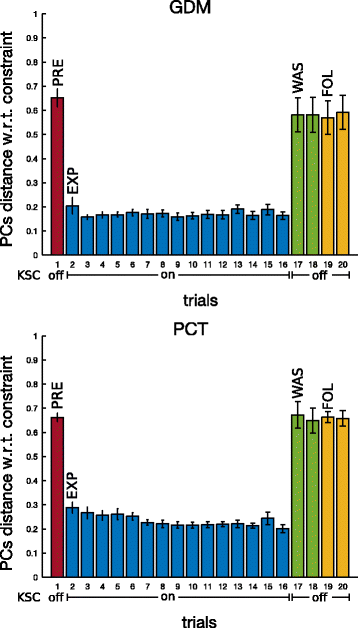Modifying upper-limb inter-joint coordination in healthy subjects by training with a robotic exoskeleton
- PMID: 28606179
- PMCID: PMC5469138
- DOI: 10.1186/s12984-017-0254-x
Modifying upper-limb inter-joint coordination in healthy subjects by training with a robotic exoskeleton
Abstract
Background: The possibility to modify the usually pathological patterns of coordination of the upper-limb in stroke survivors remains a central issue and an open question for neurorehabilitation. Despite robot-led physical training could potentially improve the motor recovery of hemiparetic patients, most of the state-of-the-art studies addressing motor control learning, with artificial virtual force fields, only focused on the end-effector kinematic adaptation, by using planar devices. Clearly, an interesting aspect of studying 3D movements with a robotic exoskeleton, is the possibility to investigate the way the human central nervous system deals with the natural upper-limb redundancy for common activities like pointing or tracking tasks.
Methods: We asked twenty healthy participants to perform 3D pointing or tracking tasks under the effect of inter-joint velocity dependant perturbing force fields, applied directly at the joint level by a 4-DOF robotic arm exoskeleton. These fields perturbed the human natural inter-joint coordination but did not constrain directly the end-effector movements and thus subjects capability to perform the tasks. As a consequence, while the participants focused on the achievement of the task, we unexplicitly modified their natural upper-limb coordination strategy. We studied the force fields direct effect on pointing movements towards 8 targets placed in the 3D peripersonal space, and we also considered potential generalizations on 4 distinct other targets. Post-effects were studied after the removal of the force fields (wash-out and follow up). These effects were quantified by a kinematic analysis of the pointing movements at both end-point and joint levels, and by a measure of the final postures. At the same time, we analysed the natural inter-joint coordination through PCA.
Results: During the exposition to the perturbative fields, we observed modifications of the subjects movement kinematics at every level (joints, end-effector, and inter-joint coordination). Adaptation was evidenced by a partial decrease of the movement deviations due to the fields, during the repetitions, but it occurred only on 21% of the motions. Nonetheless post-effects were observed in 86% of cases during the wash-out and follow up periods (right after the removal of the perturbation by the fields and after 30 minutes of being detached from the exoskeleton). Important inter-individual differences were observed but with small variability within subjects. In particular, a group of subjects showed an over-shoot with respect to the original unexposed trajectories (in 30% of cases), but the most frequent consequence (in 55% of cases) was the partial persistence of the modified upper-limb coordination, adopted at the time of the perturbation. Temporal and spatial generalizations were also evidenced by the deviation of the movement trajectories, both at the end-effector and at the intermediate joints and the modification of the final pointing postures towards targets which were never exposed to any field.
Conclusions: Such results are the first quantified characterization of the effects of modification of the upper-limb coordination in healthy subjects, by imposing modification through viscous force fields distributed at the joint level, and could pave the way towards opportunities to rehabilitate pathological arm synergies with robots.
Keywords: Force fields adaptation; Motor coordination learning; Motor redundancy; Rehabilitation robotics; Upper-limb robotic exoskeletons.
Figures















References
-
- Taub E, Uswatte G, Mark VW, Morris DM. The learned nonuse phenomenon: implications for rehabilitation. Eura Medicophys. 2006;42(3):241–56. - PubMed
-
- Krakauer JW. Motor learning: its relevance to stroke recovery and neurorehabilitation. Current Opin Neurol. 2006;19(1):84–90. doi: 10.1097/01.wco.0000200544.29915.cc. - DOI - PubMed
MeSH terms
LinkOut - more resources
Full Text Sources
Other Literature Sources
Research Materials

